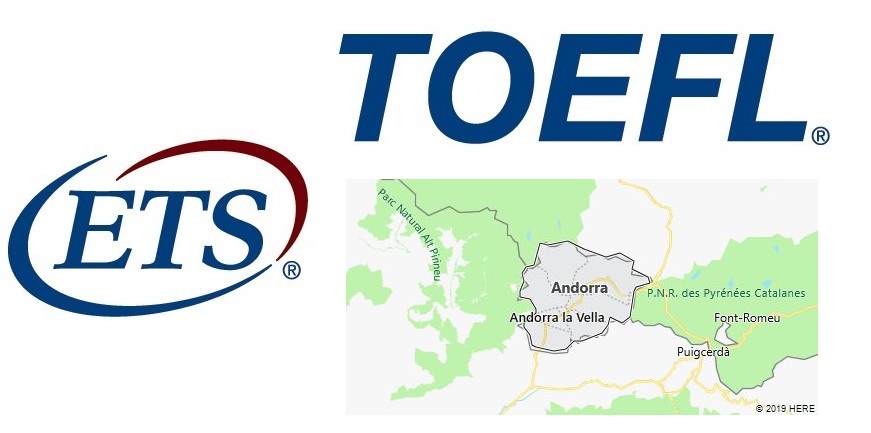The TOEFL iBT test is offered in this location.
The list below shows testing regions, fees and dates as of February 15, 2019, but availability may change when you register. Fees are shown in US$ and are subject to change without notice.
| Region | Testing Format | Fee | Test Dates |
|---|---|---|---|
| Andorra | TOEFL iBT | $225 $225 $225 $225 |
Fri., Apr 05, 2019 Fri., May 10, 2019 Sat., Jun 15, 2019 Sat., Jul 27, 2019 |
Andorra
Andorra, a small state in the eastern Pyrenees between Spain and France. The poor soil allows only sheep, cattle and horse breeding, so that today trade and tourism are the main sources of income.
History: Andorra is an independent parliamentary principality that is formally subject to the sovereignty of the French President and the Spanish Bishop von Urgel (both of which, however, only have a purely representative function). France represents the country’s foreign policy interests. Andorra joined the UN in 1993 and the Council of Europe in 1994.
Around 22,500 people live in the capital of the Principality, Andorra la Vella.
Geography
Location
Andorra lies between Spain and France, embedded in a ring of high mountain ranges (including the Vall del Madriu-Perafita-Claror mountain landscape, which is a UNESCO World Heritage Site and covers around 10% of the country’s area).
The highest point is the Coma Pedrosa with 2,946 m above sea level. Coming from high-altitude glacial valleys with lakes and alpine meadows, the source streams of the Valira unite in the Andorra la Vella valley basin, which is 800–1,100 m above sea level.
The Valira valley enables the connection to the Spanish Segretal and the city of Seu d’Urgell; the road to the French Ariègetal overcomes the Pyrenees main ridge in the 2,407 m high pass Port d’Envalira (the highest pass road in the Pyrenees).
Climate
The climate is alpine; warm summers with temperatures up to 30 ° C (average temperature in July 19 ° C) and long snowy winters (average temperature in January + 2 ° C), which make the passes impassable from November to May. The rainfall (886 mm in Les Escaldes) is evenly distributed over the year.
Country facts
- Official name: Principality of Andorra
- License plate: AND
- ISO-3166: AD, AND (20)
- Internet domain:.ad
- Currency: 1 euro (€) = 100 cents
- Area: 470 km²
- Population (2018): 77,000
- Capital: Andorra la Vella
- Official language (s): Catalan
- Form of government: Parliamentary principality
- Administrative division: 7 municipalities (Parròquies)
- Head of State: Head of State of France (Emmanuel Macron) and the Spanish Bishop of Urgell (Joan Enric Vives i Sicília)
- Head of Government: Xavier Espot Zamora
- Religion (s): Christians (Catholics)
- Time zone: Central European Time
- National holiday: September 8th
Location and infrastructure
- Location (geographical): Southwestern Europe
- Position (coordinates): between 42 ° 25 ‘and 42 ° 40’ north latitude and 1 ° 30 ‘and 1 ° 47’ east longitude
- Climate: A humid mountain climate with snowy winters and mild summers
- Highest mountain: Coma Pedrosa (2,946 m)
- Road network (2019): 320 km
Population
- Annual population growth (2020): -0.06%
- Birth rate (2020): 7 per 1000 residents.
- Death rate (2020): 7.7 per 1000 residents.
- Average age (2020): 46.2 years
- Average life expectancy (2020): 83 years (men 80.8; women 85.4)
- Age structure (2020): 13.4% younger than 15 years, 17.4% older than 65 years
- Literacy rate (15-year-olds and older) (2016): 100%
- Mobile phone contracts (pre-paid and post-paid) (2017): 104 per 100 residents
- Internet users (2017): 99 per 100 residents
Economy
- GDP per capita: n / a
- Total GDP: n / a
- GNI per capita: n / a
- Education expenditure (2017): 3.2% of GDP
- Military expenditure: n / a
- Unemployment rate (15 years and older): n / a
Population and Religion
Population
Of the population, only 46% are Catalan- speaking Andorrans, around 26% are Spanish, 14% Portuguese, 5% French. In addition to the national language, French and Spanish are widely used as educational and lingua franca. The population density is 164 residents / km 2, the proportion of urban residents is 84%. The largest towns are the capital Andorra la Vella and the thermal baths Les Escaldes-Engordany.
The biggest cities in Andorra
| Biggest Cities (Inh. 2019) | |
| Andorra la Vella | 19 400 |
| Escaldes-Engordany | 14 600 |
| Sant Julià de Lòria | 7 600 |
| Encamp | 7 600 |
| La Massana | 5,400 |
Religion
The constitution guarantees religious freedom and, with reference to the Andorran tradition, expressly emphasizes the legal guarantee for the Catholic Church and its institutions. Relations between the state and the Catholic Church have been regulated since 2008 by the State Church Treaty concluded with the Holy See on March 17, 2008. Over 88% of the population belong to the Catholic Church (part of the Spanish diocese of La Seu d’Urgell / Seo de Urgel); there are also Jehovah’s Witnesses as well as Protestants and a small Jewish community. Almost 9% are classified as not religiously bound.

